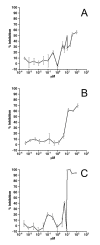Peptide inhibitors of dengue virus and West Nile virus infectivity
- PMID: 15927084
- PMCID: PMC1177995
- DOI: 10.1186/1743-422X-2-49
Peptide inhibitors of dengue virus and West Nile virus infectivity
Abstract
Viral fusion proteins mediate cell entry by undergoing a series of conformational changes that result in virion-target cell membrane fusion. Class I viral fusion proteins, such as those encoded by influenza virus and human immunodeficiency virus (HIV), contain two prominent alpha helices. Peptides that mimic portions of these alpha helices inhibit structural rearrangements of the fusion proteins and prevent viral infection. The envelope glycoprotein (E) of flaviviruses, such as West Nile virus (WNV) and dengue virus (DENV), are class II viral fusion proteins comprised predominantly of beta sheets. We used a physio-chemical algorithm, the Wimley-White interfacial hydrophobicity scale (WWIHS) in combination with known structural data to identify potential peptide inhibitors of WNV and DENV infectivity that target the viral E protein. Viral inhibition assays confirm that several of these peptides specifically interfere with target virus entry with 50% inhibitory concentration (IC50) in the 10 microM range. Inhibitory peptides similar in sequence to domains with a significant WWIHS scores, including domain II (IIb), and the stem domain, were detected. DN59, a peptide corresponding to the stem domain of DENV, inhibited infection by DENV (>99% inhibition of plaque formation at a concentrations of <25 microM) and cross-inhibition of WNV fusion/infectivity (>99% inhibition at <25 microM) was also demonstrated with DN59. However, a potent WNV inhibitory peptide, WN83, which corresponds to WNV E domain IIb, did not inhibit infectivity by DENV. Additional results suggest that these inhibitory peptides are noncytotoxic and act in a sequence specific manner. The inhibitory peptides identified here can serve as lead compounds for the development of peptide drugs for flavivirus infection.
Figures







References
-
- White SH, Snider C, Jaysinghe S, Kim J. Membrane Protein Explorer version 2.2a. http://blancobiomoluciedu/mpex/ 2003.
-
- Gallaher WR, Ball JM, Garry RF, Griffin MC, Montelaro RC. A general model for the transmembrane proteins of HIV and other retroviruses. AIDS Res Hum Retroviruses. 1989;5:431–440. - PubMed
MeSH terms
Substances
LinkOut - more resources
Full Text Sources
Other Literature Sources

